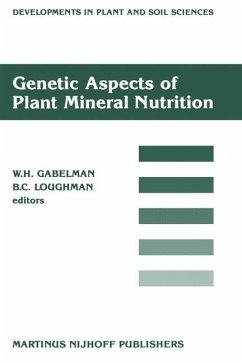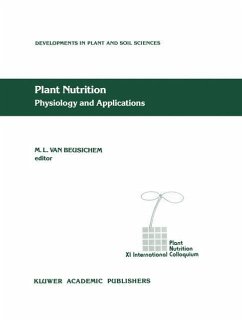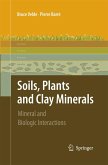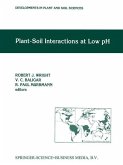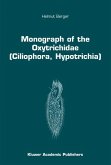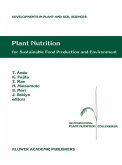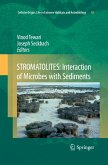Genetic Aspects of Plant Mineral Nutrition
Proceedings of the Second International Symposium on Genetic Aspects of Plant Mineral Nutrition, organized by the University of Wisconsin, Madison, June 16¿20, 1985
Herausgegeben:Gabelman, W. H.; Loughman, B. C.
Genetic Aspects of Plant Mineral Nutrition
Proceedings of the Second International Symposium on Genetic Aspects of Plant Mineral Nutrition, organized by the University of Wisconsin, Madison, June 16¿20, 1985
Herausgegeben:Gabelman, W. H.; Loughman, B. C.
- Broschiertes Buch
- Merkliste
- Auf die Merkliste
- Bewerten Bewerten
- Teilen
- Produkt teilen
- Produkterinnerung
- Produkterinnerung
This volume presents the proceedings of the Second International Sym posium on Genetic Aspects ofPlant Minerai Nutrition, held in Madison, Wisconsin in 1985. The mechanisms by which plants acquire, transport and utilize essential minerai nutrients are highly complex. The means by which plants either exclude or tolerate ions of metals toxic to plants are equally complex. The first symposium attempted to convene research scientists con cerned with minerai nutrition for the purpose of exploring the kinds of minerai nutrition phenomena identified as being under genetic contro!. The first symposium…mehr
Andere Kunden interessierten sich auch für
![Plant Nutrition - Physiology and Applications Plant Nutrition - Physiology and Applications]() Plant Nutrition - Physiology and Applications76,99 €
Plant Nutrition - Physiology and Applications76,99 €![Soils, Plants and Clay Minerals Soils, Plants and Clay Minerals]() Pierre VeldeSoils, Plants and Clay Minerals84,99 €
Pierre VeldeSoils, Plants and Clay Minerals84,99 €![Plant-Soil Interactions at Low pH Plant-Soil Interactions at Low pH]() Plant-Soil Interactions at Low pH403,99 €
Plant-Soil Interactions at Low pH403,99 €![Monograph of the Oxytrichidae (Ciliophora, Hypotrichia) Monograph of the Oxytrichidae (Ciliophora, Hypotrichia)]() Helmut BergerMonograph of the Oxytrichidae (Ciliophora, Hypotrichia)224,99 €
Helmut BergerMonograph of the Oxytrichidae (Ciliophora, Hypotrichia)224,99 €![Plant Nutrition for Sustainable Food Production and Environment Plant Nutrition for Sustainable Food Production and Environment]() Plant Nutrition for Sustainable Food Production and Environment224,99 €
Plant Nutrition for Sustainable Food Production and Environment224,99 €![Dietary Fiber Dietary Fiber]() Dietary Fiber38,99 €
Dietary Fiber38,99 €![STROMATOLITES: Interaction of Microbes with Sediments STROMATOLITES: Interaction of Microbes with Sediments]() STROMATOLITES: Interaction of Microbes with Sediments150,99 €
STROMATOLITES: Interaction of Microbes with Sediments150,99 €-
-
-
This volume presents the proceedings of the Second International Sym posium on Genetic Aspects ofPlant Minerai Nutrition, held in Madison, Wisconsin in 1985. The mechanisms by which plants acquire, transport and utilize essential minerai nutrients are highly complex. The means by which plants either exclude or tolerate ions of metals toxic to plants are equally complex. The first symposium attempted to convene research scientists con cerned with minerai nutrition for the purpose of exploring the kinds of minerai nutrition phenomena identified as being under genetic contro!. The first symposium also placed much emphasis on research to which genetic intervention might be applied. At the second symposium more papers were presented on genetic and breeding research, a long-term objective of the first symposium. The second symposium also included biotic interactions under genetic con trol that either enhanced or impeded ion uptake, e.g. mycorrhizae and nitrogen fixing bacteria. This continuing dialogue is essential for a research area the complexity of which is due to its interdisciplinary nature.
Hinweis: Dieser Artikel kann nur an eine deutsche Lieferadresse ausgeliefert werden.
Hinweis: Dieser Artikel kann nur an eine deutsche Lieferadresse ausgeliefert werden.
Produktdetails
- Produktdetails
- Developments in Plant and Soil Sciences 27
- Verlag: Springer / Springer Netherlands
- Artikelnr. des Verlages: 978-94-010-8102-3
- Softcover reprint of the original 1st ed. 1987
- Seitenzahl: 640
- Erscheinungstermin: 22. Oktober 2011
- Englisch
- Abmessung: 240mm x 160mm x 35mm
- Gewicht: 1006g
- ISBN-13: 9789401081023
- ISBN-10: 9401081026
- Artikelnr.: 39494654
- Herstellerkennzeichnung Die Herstellerinformationen sind derzeit nicht verfügbar.
- Developments in Plant and Soil Sciences 27
- Verlag: Springer / Springer Netherlands
- Artikelnr. des Verlages: 978-94-010-8102-3
- Softcover reprint of the original 1st ed. 1987
- Seitenzahl: 640
- Erscheinungstermin: 22. Oktober 2011
- Englisch
- Abmessung: 240mm x 160mm x 35mm
- Gewicht: 1006g
- ISBN-13: 9789401081023
- ISBN-10: 9401081026
- Artikelnr.: 39494654
- Herstellerkennzeichnung Die Herstellerinformationen sind derzeit nicht verfügbar.
Section 1: Responses of wild plant ecotypes to nutrient deficiency stress.- Genetical aspects of mineral nutrition - Progress to date.- Adaptations and physiological responses of wild plants to nutrient stress.- Application of ANE value and of shares of individual elements in this value for determining the difference between various plant species.- Variation in foliar elemental composition in Vaccinium crosses.- Section 2: Screening techniques to detect nutritional differences under genetic control.- Intact-plant screening for tolerance of nutrient-deficient stress.- Somatic cell selection of mutants resistant to mineral stress.- Screening spring wheat for drought tolerance.- Identifying aluminum tolerance in sorghum genotypes grown on tropical acid soils.- Influence of field sampling techniques on the Al, Mn, Mg, and Ca nutritional profiles for acid soil tolerant susceptible sorghum genotypes.- Section 3: Tolerance to salinity and to metal toxicities.- Advances in salt tolerance.- Intervarietal ionic composition changes in barley under salt stress.- Boron tolerance in Australian varieties of wheat and barley.- Australian research on tolerance to toxic manganese.- Tolerance of plants to heavy metals.- Hydrogen and aluminium tolerance.- Tolerances of Old World bluestems to an acid soil high in exchangeable aluminum.- Comparisons of maize populations for aluminum tolerance in nutrient solution.- Inheritance of aluminum tolerance in maize.- Aluminum tolerance in sorghum.- Responses of Al-tolerant and Al-sensitive Kearney barley cultivars to calcium and magnesium during Al stress.- Ion segregation in different plant parts within different barley cultivars under salt stress.- Plant traits for evaluation of responses of sorghum genotypes to aluminum.- Elevation of inbredlines for aluminum tolerance in nutrient solution.- Section 4A: Genotypic response to nutrient deficiency: Macronutrients.- The application of in vivo techniques in the study of metabolic aspects of ion absorption in crop plants.- Genotypic variation in biomass production and nitrogen use efficiency in pearl millet [Pennisetum americanum (L.) Leeke].- Differential phosphorus uptake, distribution, and efficiency by sorghum inbred parents and their hybrids.- External phosphorus requirements of five tropical grain legumes in flowing-solution culture.- Genetics and physiology of low-phosphorus tolerance in a family derived from two differentially adapted strains of tomato (Lycopersicon esculentum Mill.).- Genotypic differences in the chemical composition of maize plants grown on a calcareous Chernozem.- Genotypic differences in subcellular compartmentation of K +: Implications for protein synthesis, growth and yield.- Root morphological effects on Mg uptake in five tall fescue lines.- Influence of different Triticum aestivum L. genomes and chromosomes on the assimilation of the main nutrient elements.- The accumulation and distribution of sodium in tomato strains differing in potassium efficiency when grown under low-K stress.- Vegetative adaptation to N stress regimes in two barley cultivars with different N requirement.- Genetic differences among wild oat lines in potassium uptake and growth in relation to potassium supply.- Genetic variation in the uptake and utilization of potassium in wheat (Triticum aestivum) varieties grown under potassium stress.- Inheritance of response of sunflower inbreds to a low calcium/magnesium ratio.- Genetic differences in the ear-leaf nutrient content of inbred lines of corn (Zea mays L.).- Section 4B: Genotypic response to nutrient deficiency: Trace elements.- Transfer to wheat of the copper efficiency factor carried on rye chromosome arm 5RL.- Physiology of genotypic differences in zinc and copper uptake in rice and tomato.- Variability and correlation of iron-deficiency symptoms in a sorghum population evaluated in the field and growth chamber.- Sorghum genotype differences in uptake and use efficiency of mineral elements.- Resistance to the European corn borer, Ostrinia nubilalis (Hubner), in maize, Zea mays L., as affected by soil silica, plant silica, structural carbohydrates, and lignin.- Differential response of sunflower genotypes to iron deficiency.- Soybean genetic differences in response to Fe and Mn: Activity of metalloenzymes.- Ultrastructure of mesophyll cells grown on different levels of selenium of two pea genotypes.- Section 5: Genetic variation in microorganism host interactions in mineral nutrition.- Host plant control of symbiotic N2 fixation in grain legumes.- Specific relations between some strains; of diazotrophs and corn hybrids.- Nitrogen fixation in soybean as influenced by cultivar and Rhizobium strain.- Intraspecific variability for VA mycorrhizal symbiosis in Cowpea (Vigna unguiculata [L.] Walp.).- Section 6: Germplasm resources and modification.- Sources of germplasm for research on mineral nutrition.- Incorporation of phosphorus efficiency from exotic germplasm into agriculturally adapted germplasm of common bean (Phaseolus vulgaris L.).- Genetic variability for mineral element concentrations in smooth bromegrass related to dairy cattle nutritional requirements.- Molecular cloning of the plant plasma membrane H+-ATPase.- Control of nutrient concentrations in plant growth media.- Considerations of vesicular-arbuscular mycorrhiza physiology in breeding for enhanced mineraluptake by plants.- Progress since the first international symposium: Genetic aspects of plant mineral nutrition, Beograd, 1982, and perspectives of future research.
Section 1: Responses of wild plant ecotypes to nutrient deficiency stress.- Genetical aspects of mineral nutrition - Progress to date.- Adaptations and physiological responses of wild plants to nutrient stress.- Application of ANE value and of shares of individual elements in this value for determining the difference between various plant species.- Variation in foliar elemental composition in Vaccinium crosses.- Section 2: Screening techniques to detect nutritional differences under genetic control.- Intact-plant screening for tolerance of nutrient-deficient stress.- Somatic cell selection of mutants resistant to mineral stress.- Screening spring wheat for drought tolerance.- Identifying aluminum tolerance in sorghum genotypes grown on tropical acid soils.- Influence of field sampling techniques on the Al, Mn, Mg, and Ca nutritional profiles for acid soil tolerant susceptible sorghum genotypes.- Section 3: Tolerance to salinity and to metal toxicities.- Advances in salt tolerance.- Intervarietal ionic composition changes in barley under salt stress.- Boron tolerance in Australian varieties of wheat and barley.- Australian research on tolerance to toxic manganese.- Tolerance of plants to heavy metals.- Hydrogen and aluminium tolerance.- Tolerances of Old World bluestems to an acid soil high in exchangeable aluminum.- Comparisons of maize populations for aluminum tolerance in nutrient solution.- Inheritance of aluminum tolerance in maize.- Aluminum tolerance in sorghum.- Responses of Al-tolerant and Al-sensitive Kearney barley cultivars to calcium and magnesium during Al stress.- Ion segregation in different plant parts within different barley cultivars under salt stress.- Plant traits for evaluation of responses of sorghum genotypes to aluminum.- Elevation of inbredlines for aluminum tolerance in nutrient solution.- Section 4A: Genotypic response to nutrient deficiency: Macronutrients.- The application of in vivo techniques in the study of metabolic aspects of ion absorption in crop plants.- Genotypic variation in biomass production and nitrogen use efficiency in pearl millet [Pennisetum americanum (L.) Leeke].- Differential phosphorus uptake, distribution, and efficiency by sorghum inbred parents and their hybrids.- External phosphorus requirements of five tropical grain legumes in flowing-solution culture.- Genetics and physiology of low-phosphorus tolerance in a family derived from two differentially adapted strains of tomato (Lycopersicon esculentum Mill.).- Genotypic differences in the chemical composition of maize plants grown on a calcareous Chernozem.- Genotypic differences in subcellular compartmentation of K +: Implications for protein synthesis, growth and yield.- Root morphological effects on Mg uptake in five tall fescue lines.- Influence of different Triticum aestivum L. genomes and chromosomes on the assimilation of the main nutrient elements.- The accumulation and distribution of sodium in tomato strains differing in potassium efficiency when grown under low-K stress.- Vegetative adaptation to N stress regimes in two barley cultivars with different N requirement.- Genetic differences among wild oat lines in potassium uptake and growth in relation to potassium supply.- Genetic variation in the uptake and utilization of potassium in wheat (Triticum aestivum) varieties grown under potassium stress.- Inheritance of response of sunflower inbreds to a low calcium/magnesium ratio.- Genetic differences in the ear-leaf nutrient content of inbred lines of corn (Zea mays L.).- Section 4B: Genotypic response to nutrient deficiency: Trace elements.- Transfer to wheat of the copper efficiency factor carried on rye chromosome arm 5RL.- Physiology of genotypic differences in zinc and copper uptake in rice and tomato.- Variability and correlation of iron-deficiency symptoms in a sorghum population evaluated in the field and growth chamber.- Sorghum genotype differences in uptake and use efficiency of mineral elements.- Resistance to the European corn borer, Ostrinia nubilalis (Hubner), in maize, Zea mays L., as affected by soil silica, plant silica, structural carbohydrates, and lignin.- Differential response of sunflower genotypes to iron deficiency.- Soybean genetic differences in response to Fe and Mn: Activity of metalloenzymes.- Ultrastructure of mesophyll cells grown on different levels of selenium of two pea genotypes.- Section 5: Genetic variation in microorganism host interactions in mineral nutrition.- Host plant control of symbiotic N2 fixation in grain legumes.- Specific relations between some strains; of diazotrophs and corn hybrids.- Nitrogen fixation in soybean as influenced by cultivar and Rhizobium strain.- Intraspecific variability for VA mycorrhizal symbiosis in Cowpea (Vigna unguiculata [L.] Walp.).- Section 6: Germplasm resources and modification.- Sources of germplasm for research on mineral nutrition.- Incorporation of phosphorus efficiency from exotic germplasm into agriculturally adapted germplasm of common bean (Phaseolus vulgaris L.).- Genetic variability for mineral element concentrations in smooth bromegrass related to dairy cattle nutritional requirements.- Molecular cloning of the plant plasma membrane H+-ATPase.- Control of nutrient concentrations in plant growth media.- Considerations of vesicular-arbuscular mycorrhiza physiology in breeding for enhanced mineraluptake by plants.- Progress since the first international symposium: Genetic aspects of plant mineral nutrition, Beograd, 1982, and perspectives of future research.

